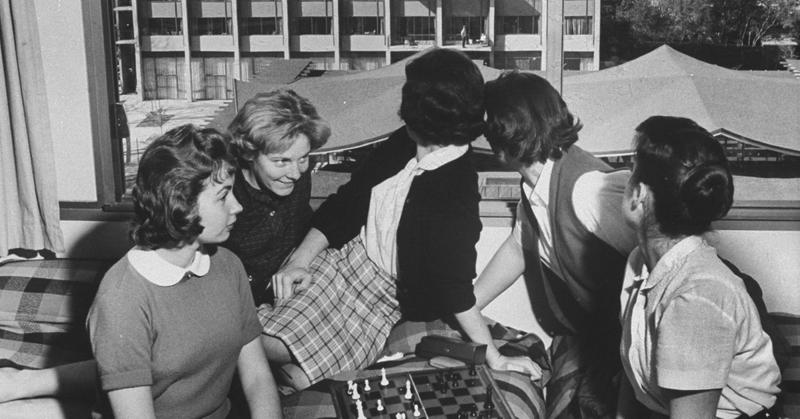You Won’t Believe These College Dorm Rooms Of The 1960s
By | September 24, 2018

College dormitories in the 1960s were small, spartan affairs that might look primitive to today's students. College life has changed in so many ways since the 1960s and one of the most noticeable changes is in the dorm room. Today’s newer college dorms can be downright luxurious compared to the cramped, cinder-block squares that the sixties college students lived in. Amenities were scarce, as were members of the opposite sex. A glimpse at some of the uncomfortable college dorm rooms from the 1960s will make you understand why students flocked to the library to study. Despite how inhospitable they seem, college students made the most of dorm life in the sixties.
Dorm Life Meant A Lack of Privacy

Four students, sometimes more, crowded into a tiny room with narrow beds or bunk beds in 1960s college dormitories. Living in such close proximity to one’s roommates meant that privacy was non-existent. Students had to sleep, study and change their clothes in front of each other. And one’s belongings were up for grabs, too, since there was little storage space and certainly no locked closets.
Shared Showers Were A Part Of The Dorm Life Experience

Rare was the college dorm room with its own bathroom! Most dorm buildings had communal showers and bathrooms located somewhere down the hall. Much like the open showers we see in high school locker rooms, the communal showers made no attempt at ensuring privacy. Students quickly learned the best times to shower with the fewest people. That often meant showering late at night or super early in the morning.
No Boys Allowed! Or Girls!

Sixties college dorm rooms were off limits to members of the opposite sex. In fact, most dormitory buildings were established as girls-only or boys-only. It wasn’t until much later, in the late 1970s and early 1980s, that dorm buildings were co-ed. And even then, the genders were kept separated by floors or wings. In the sixties, most college dorms had strict rules prohibiting members of the opposite sex from visiting a dorm room. Young lovers sometimes got around this rule by sneaking their boyfriend or girlfriend into the building, past the dorm mother or dorm advisor.
Dorm Living Meant Lots Of Stairs

Until the American With Disabilities Act of 1990 made it mandatory that ramps and elevators be installed in every college dorm buildings, most dormitories lacked elevators. If one lived on an upper floor, they had to resign themselves to daily stair climbs, often lugging heavy books. This was especially dreadful on move-in day when students had to lug over-sized suitcases up the flights of stairs to their room.
There Were No Televisions In Dorm Rooms

Although the 1960s saw a huge increase in television and television ownership, college students did not bring a TV with them to their dorm rooms. It was still rare for families to own more than one television set and the television sets of the 1960s were bulky, heavy items that would be too large for a sixties-style dorm room. Most colleges and universities prohibited students from bringing their own TV into their dorm room. That didn’t mean that college students missed out on watching the great television shows of the era. Most dormitories had a student lounge with a TV for students to watch. Of course, they all had to agree on what channel to watch.
People Smoked Whether You Liked It Or Not

Here's something that will blow the minds of college kids today: People smoked cigarettes everywhere. In 1865, almost half of Americans were smokers, and smokers felt free to light up in workplaces, on airplanes, and of course in college dorm rooms. Smoking, and dealing with smokers, was such an accepted fact of life that asking someone not to smoke around you was pretty much rude. If you were a non-smoker in college in the 1960s, and your roommate or roommates smoked, you might just have to put up with it.
Dorm Life Meant A Lot Of Rules

Living in a dorm didn’t necessarily mean a first taste of freedom for young college students in the 1960s. Dorm life was lorded over by a dorm mother or dorm adviser who enforced the rules. And, often, there were a lot of rules to abide by. The dorm mother made sure students were dressed appropriately and met the school dress code; made sure they got enough to eat; made sure they were in their rooms by curfew time and made sure they were in their beds by lights-out time. They even made sure the dorm rooms were kept clean and that students were making their beds each morning.
No Food Allowed

Colleges and universities provided a dining hall or cafeteria for its resident students. Often, meals were served at specific times and food choices were limited. Today’s college students would simply bring a mini-fridge to their dorm room or order a pizza, but in the 1960s, it was uncommon for dorm mothers to allow students to have food in their rooms.
'60s Dorm Rooms Were Utilitarian

The no-frills approach to dorm life of the 1960s followed a long-held ideology about college life in general. The belief was that, as college students, the young adults should commit their entire lives to study. The sparsely furnished dorm rooms – typically just a twin sized bed and small desk per student – were designed for sleep and study only, not for socializing or entertaining. The change in dorm room design only came about when college and university officials began to realize that students were enrolling in college for more than the academics; they wanted the college experience. Only then did college dorm rooms evolve to give students the experience they were seeking.
